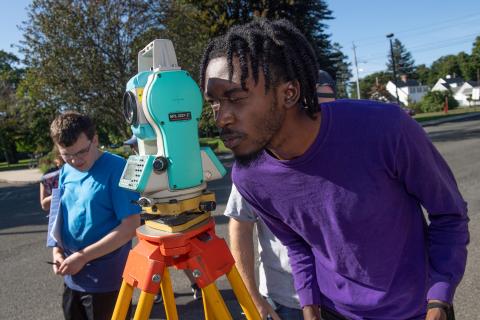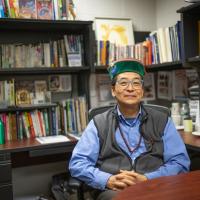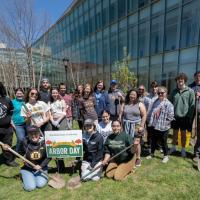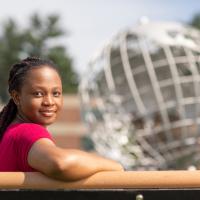
Geography, Planning, and Sustainability Department Expands Concentrations

The Geography, Planning, and Sustainability Department (GPS) at Westfield State has expanded to include a total of six concentrations: Cities and Social Justice, Climate and Energy, Environmental Planning, Food Systems, Real Estate and Economic Development, and Urban Design and Architecture. After changing the title of the department in recent years to include “Sustainability”, the major itself has transformed to encompass the diverse fields of study in which students can engage.
“For a long time, the regional planning major had two concentrations: environmental planning and urban planning,” Brian Conz, Professor and Chair of the Department of Geography, Planning, and Sustainability said. “We felt that only having these two majors didn't fully represent the scope of topics and work that urban and regional planners engage in. This is partly a way of getting across the range of issues that urban regional planning planners are involved in, but also giving students a chance to develop their specialties within the larger field.”
However, no matter the differences in concentration, these integral components of our society all converge somewhere in the middle, Conz said. “Planners work across different scales from city blocks and historic preservation to planning for entire regions or thinking about water supply and transportation networks. All planning, to some extent, is city planning, because cities and towns and settlements are fundamental to the work that they do.”
The first new concentration focuses on the social justice facets of urban planning. "The social justice piece is really calling attention to the importance in contemporary planning of involving in creating a more inclusive planning process,” Conz said. “Throughout history, it was a very top-down process and was done by the powerful and often time to the exclusion and marginalization of many different groups in society. Contemporary planning involves a lot of effort to make the planning process more inclusive to include the voices of every community. One of the big themes in this concentration is fair and affordable housing.”
Meanwhile, for students looking to better engage with long-term sustainability options, Conz encourages prospective urban planners to explore that aspect of the major. “We’re looking to help students develop specializations that will enable them to be to take part in the energy transitions that are happening across the country and around the world,” he said. “A lot of it is thinking through the infrastructure changes that are unfolding as we speak. Some of that is regulatory and policy oriented, and a lot of it is trying to a better understand the challenges we're facing.”
As with many departments of the University, Conz explained the link faculty often sees between students double majoring in biology and geography. Because these connections translate to real world possibilities, Conz thought it appropriate to expand their major to include a more accurate representation of career opportunities utilizing each discipline.
“Our environmental science program at Westfield State was originally a collaborative venture between biology and geography and regional planning,” he said. “That program has grown, and we provide many courses that serve that major. A lot of the environmental science students get jobs as environmental planners, and a lot of them double major with us. Environmental planning as a concentration runs the gamut of activities from wetlands planning and delineation ensuring the integrity of natural systems as development processes unfold. It can also involve conservation planning, planning for protected areas or trails in natural resource, conservation, and management.”
The fourth new concentration explores the intersection between urban planning and food systems within communities. “Food systems is this sort of subfield of planning started to emerge in the early 2010’s,” Conz said. “The American Planning Association put out their first booklet treatment of the topic community and regional food planning back in 2008. We’re trying to respond to student interest around issues of food, security, insecurity, urban agriculture, and rebuilding regional food systems. There's been tremendous interest for a variety of reasons… one is climate and energy issues, where we've been trying to shorten supply chains and rebuild regional food economies and sources. The explosion of farmers markets, and interest in locally grown food is something that's very prevalent in that.”
Economic development “is a big concern of planners,” Conz explained, where “planners are charged with creating more livable and economically vibrant communities.” From supporting storefront integrity to promoting local economies, workers in this field prioritize the “health” of a town or city, as well as its individual parts so that new businesses can flourish alongside them.
“The other side of it is that we’re hoping to expand our ability to collaborate with the economics department and the business programs because we know that students are interested in pursuing careers in real estate,” Conz said. “We offer a whole slew of different skills that can be valuable in that, like assessing parcels of raw land or assessing buildings, since planners are often involved in helping to draft building codes. There’s a skill set that we offer which could be very useful to people interested in pursuing careers in real estate, even outside of planning. We think it's a good match for folks, especially for those looking double major in business and urban and regional planning or economics.”
The last new concentration, Urban Design and Architecture, mirrors previous disciplines linked to skillsets often associated with other academic departments. “This is a collaboration with the art department,” Conz said. “Planners are oftentimes architects. They're very much sister disciplines. Planners tend to focus on, not so much on a single structure, but more on the block and the neighborhood and the city at large. There's an easy association that takes place there, and so planners need to be well versed in architectural styles and design processes. They require a lot of creativity. Both require a lot of artistic skill and appreciation and knowledge of art history, but also an appreciation for what urbanists call ‘urban fabric’, and how buildings fit into the larger story of the city. Like the other concentrations, this will also have a sustainability angle to it.”
Conz expressed enthusiasm and gratitude that faculty were able to make these new concentrations a reality for students. “It's another way of saying that there’s different avenues open to them,” he said. “When you think about urban planning, you should think about landscape architecture, urban design, site development, and real estate. Environmental and social dimensions are also important. Climate and energy are all there. We've also got an amazing network of alumni across the state that we can tap into to get students into internship positions. We can make that stuff happen to fill in any gaps.”


